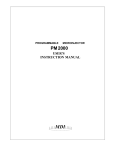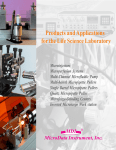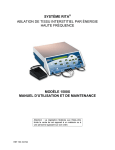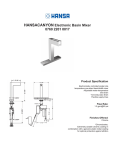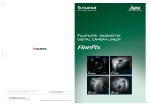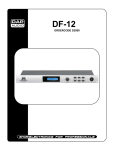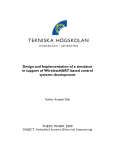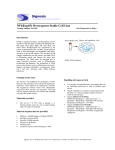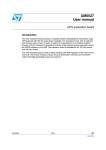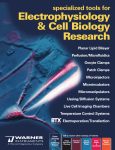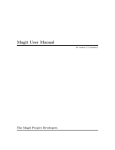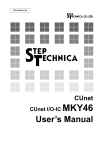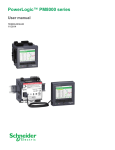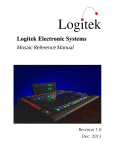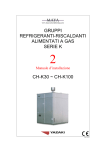Download PM 8000 - Warner Instruments
Transcript
8-CHANNEL PROGRAMMABLE PRESSURE INJECTOR PM 8000 USER'S INSTRUCTION MANUAL 12345678901234567890123456789012 12345678901234567890123456789012 12345678901234567890123456789012 12345678901234567890123456789012 12345678901234567890123456789012 12345678901234567890123456789012 MDI TABLE INTRODUCTION OF CONTENTS --------------------------------------------------------------------- 1 1. INSTALLATION ----------------------------------------------------------------Safety Requirements ------------------------------------------------------System Setup -------------------------------------------------------------Presetting Steps and Testing ----------------------------------------------Connections for Intracellular Injection System --------------------------Connections for Extracellular Microperfusion System ----------------- 2 2 2 4 5 6 2. A CLOSER LOOK AT THE INJECTOR Front Panel ----------------------------------------------------------------Rear Panel ------------------------------------------------------------------The Key Pad -------------------------------------------------------------------Optional Mouse ----------------------------------------------------------------- 7 7 8 9 10 3. OPERATING AND PROGRAMMING -----------------------------------After Turning On the Power --------------------------------------------------Mode 1: Auto. Sequence --------------------------------------------------Mode 2: Pressure Monitor -------------------------------------------------Mode 3: Timer ---------------------------------------------------------------Mode 4: Counter ------------------------------------------------------------Mode 5: Action --------------------------------------------------------------- 11 11 11 14 15 16 17 4. PRINCIPLES AND TECHNIQUES FOR MICROINJECTION Using The Balance Pressure ---------------------------------------------Microinjection for Different Tip Openings -----------------------------Manual Controlling Actions for a New User --------------------------Saving Gas ------------------------------------------------------------------- 19 19 20 20 21 5. CAUTIONS AND TROUBLE SHOOTING -------------------------------- 22 6. SPECIFICATIONS ---------------------------------------------------------------- 23 7. ACCESSORIES ------------------------------------------------------------------ 24 8. WARRANTY ---------------------------------------------------------------------- 25 9. REMOTE PORT TECHNICAL REFERENCE ----------------------------- 26 MDI 12/02 S/W: PM008 V5.1 INTRODUCTION . . . . . KEY FEATURES: Complete capabilities for microinjection and perfusion. Up to eight inject/perfusion outputs, one hold cell output and one synchronized drain out channel. Programmable and savable timers, counters and step sequences. High speed channel action and flexible channel combination. Convenient manual control or automatic sequential step cycle operation. The PM 8000 Programmable 8-Channel Pressure Injector is designed for intracellular injection and extracellular perfusion. It can be used for directly injecting different molecular agents, labelled dyes, genes, RNA, DNA, proteins and cell organelles to a cell, or performing one of various combinations perfusion from eight different agents and drugs to a cell or a group of cells. It is also a superior device for intracytoplasmic sperm injection and cell electrophysiology. By combining an advanced microcontroller and precise pneumatic components, the PM 8000 can simultaneously control eight injection micropipettes, one cell holding pipette and one drain pipette. The eight injection micropipettes can be controlled separately or combined together to perform actions such as injection, capillary action balancing, suction or clear up. The cell holding pipette can produce an adjusted vacuum to hold a cell or eject a pressure to push a cell or just clear the holding pipette itself. Also, the drain pipette can produce an adjusted vacuum to drain out liquid precisely and synchronize with every microperfusion. The PM8000 can deliver different agents and drugs from picolitters to continued perfusion. The PM 8000 provides programmable timers and counters to deliver accurate timing and counting for corresponding functions. The PM 8000 allows the user to program custom-designed action sequences. There are 16 savable sequences with 32 programmable steps in each sequence. They can be used to perform and repeat different sequential injections and perfusion cycles precisely. Also, the sequential cycles can be automatically performed or triggered each step by manual. Even the interval time between steps is programmable for automatic sequential cycle. All preset timers, counters and sequential steps are saved even turn off the power. By pressing a button, even the pressure readings can be saved too. Therefore, the PM8000 is complete reproducible for an experiment at anytime. There are individual regulators for adjustments of suction vacuum, cell holding vacuum, drain vacuum, inject pressure and balance pressure. An LCD provides full information display such as pressure, vacuum, time, sequence steps and actions. During pressure mode, all pressure readings are simultaneously real-time displayed on the LCD screen so that the user can conveniently preset all the pressures without switching the pressure measurement. Meanwhile, previous pressure reading can be recovered on the LCD for further comparison. An attached foot switch can control all preset step or be used as an injection trigger. An optional remote keyboard and remote mouse give the user other convenient tools to control the whole operation or to interface with a computer. The exceptional versatility and extremely precise control are the hallmark of the PM8000. 1 1. INSTALLATION Safety Requirements: Read this manual before installation of the instrument. This instrument is intended for using in laboratory environment. This instrument needs correct power supply and correct gas source supply. [1] The power supply should be the same voltage level as the specification on the back panel and must has ground connection. [2] The gas source supply should not be higher than 100 psi. Any very active, flammable or corrosive gas can not be used as the input gas source. If using gas (nitrogen for example) other than compression air , fresh air ventilation is required. [3] Do not point output tubing, pipette to any person during operation. If not using the instrument, the power supply and gas supply should be turned off. [4] Do not disassemble the instrument box cover or service inside components. System Setup: [1] Gas Source and Tubing Connections: There is a GAS INPUT Connector on the PM8000 rear panel (See REAR PANEL). Screw the 1/8" Hose Connector into the Pressure Input Connector and connect the other end to a gas supply. Compressed air supply source is suitable for oxygen insensitive injection material. Inert gas nitrogen is suitable for air sensitive material. A pressure of 60 - 100 psi is sufficient. An input pressure of higher than 100 psi will damage the device. Any very active, flammable, corrosive or harmful gas is not recommended for the input gas source. During the system normal operation, some source gas will be bleeding from the system. If other gas instead of the compressed air is used as the input gas source, sufficient environmental air ventilation should be considered. Turn off the gas source and system when finishing an operation. There are ten gas output ports on the front panel (See FRONT PANEL). There are ten inserts with hard wall tubbing which will prevent pressure be buffered in the tubing. Two of ten tubings are 2 mm OD which can be connected to single pipette holders for injection or cell holding. Eight of ten tubings are 1.8 mm OD which can be connected to the Tygon tubing in the multipipette holder or to single pipette holders. Optional vial tubing with connector is used to for microperfusion. Screw connectors to corresponding output ports on the injector. Before connecting pipettes (before connecting vials for microperfusion ), use Clear (CLR) and Clear Hold ( CLRH ) function to blow tubbing few times. After connecting pipette to pipette holder, make sure no leakage at all connections of output port to tubbing, tubbing to vials, vials to pipette holder and pipette holder to pipette. When using CLEAR or INJECT function, be sure the pipette or tubbing opening does not point to a person. [2] Two Different Systems Set Up : If the PM8000 is used for intracellular injection, refer the CONNECTIONS FOR INTRACELLULAR INJECTION SYSTEM page for the system set up. Since small quantity agent is needed for intracellular injection, only the injection pipettes are used to fill up agents, and then inject to a cell. This set up is also referred for application of Intracytoplasmic Sperm Injection (ICSI). If the PM8000 is used for extracellular microperfusion and multi-drug testing, refer the CONNECTIONS FOR EXTRACELLULAR MICROPERFUSION SYSTEM page for the system set up. Vials or tubes should been used in this system to hold agents, drugs and drain out liquid. [3] Intracellular Injection: For intracellular injection, inject pipette is inserted to a cell from the side or from above the cell. For suspended a cell, a second , larger pipette is used to hold the cell. This pipette's tip is polished with a microforge. With its axis almost horizontal, it is moved to hold the cell with applied suction. For intracellular injection, an inject pipette is inserted to a cell from the side or upper of the cell. 2 [4] Using Micropipettes: Microinjection technique also requires skills in making and using micropipettes. Micropipettes ranging inside tip diameter from 0.10-5.0 um can be formed by a pipette puller. Change in inside tip diameter 10% will change fluid conductance by 30%. Therefore, larger tip will deliver more material but easy damage to the cell. Smaller tip need higher pressure to deliver material and easy to be clogged. A pipette with smaller tip can inject few picoliters, the smaller tip the more precise control. For the tip smaller than 10 um, a direct balance pressure can be used. If the tip larger than 20 um, a VENT function must be added to get less than 0.1 psi balance pressure (See PRINCIPLES AND TECHNIQUES FOR MICROINJECTION). [5] Foot Switch : A foot-switch or an optional handy switch can be connected to the FOOT SWITCH jack on the front panel. A negative TTL control signal can be inputted to the TRIGGER INPUT BNC connector (top of the Foot Switch Jack). It performs the same function as the AUTO key on the keyboard. An optional keyboard pad or a special mouse can be connected to the REMOTE PORT for remote control purpose. [6] Output BNCs : Besides the TRIGGER INPUT BNC, there are eight BNC connectors on the front panel which produce TTL signals corresponding to eight injections from their output ports. The TTL outputs can be used to be recorded or synchronize with the measurements responded from the microinjections or microperfusions. [7] Special Mouse and Remote Key Pad (Optional): If a special optional mouse or a remote key pad is used, insert the DB9 connector to the remote port of the unit. Place the mouse or the remote key pad near your microscope. The mouse can control the Injection, Suction and Auto-sequence conveniently and quickly. The remote key pad will perform the full function as the key pad on the unit. [8] The AC Power : The power cord must be plugged into an AC outlet with an identical voltage as specified on the rear panel. After turn on the power, the power indicating light must be on and the LCD display will display the software version number. 3 Presetting Steps and Testing : 1) Check input pressure. 30-100 psi is workable, >102psi input pressure should be reduced. Let the buzzer on during timer action. If you don't like 'beep' noise during action, turn it off ( See OPERATING ). Then press the MODE key to next mode. 2) Check and select sequences, select and preset action steps. If you plan to perform auto-sequence perfusion cycle, repeat injection cycle or use the foot switch to control action steps, programmed sequence steps are necessary ( See OPERATING ). Then press the MODE key again; 3) Check and adjust pressures. Adjust pressure regulators while you monitor the pressure display. 20 psi for injection, but do not try to adjust higher than 60 psi. 50 psi for fill, but do not try to adjust higher than 88 psi. 0.5 psi for balance is general initial pressure setting. If it is repeating last experiment, previous pressure reading can be recovered. Update pressure reading memory is capable too ( See OPERATING ). Then press the MODE key again; 4) Check and preset timers. Clear and set every timer for new sequence. 0.01 second for CLER, 0.3 second for CLRH. 0.1 second for INJx and FILL are general initial setting. More than 1 second for clear inject pipette (CLER) or for clear holding pipette (CLRH) is not recommended. Press the MODE key again; 5) Check and preset counters. Clear and set all count to 1 for new sequence. If volume is calibrated under certain pressure and time, changing count will simply double volumes. Then press the MODE key again; 6) It is ready for actions now. Before connecting pipettes to pipette holders, be sure the pipette or tubbing opening does not point to a person. Use Clear ( CLR ) and Clear Hold ( CLRH ) function to blow tubbing few times. Then, connecting inject pipette to inject pipette holder, connect cell hold pipette to cell hold pipette holder. Insert injection micropipette to some liquid (water), don’t forget press BALANCE key first to output balance pressure to the injection pipette. Slowly increase the balance pressure to push the liquid out of the pipette until all the liquid just out the pipette tip. The air should be stable in the pipette tip (See Fig. 1). If increasing the balance pressure doesn’t push the liquid inside the pipette, check any leakage at all connections of output port to tubbing, tubbing to pipette holder and pipette holder to pipette. Now, the INJ key can be pressed to try an injection. A small air bubble can be injected during the short time inject period. If the air is continue injected even the inject action indicator LED turns off, be sure the Balance or the Vent function must be turned on before injection. For detail Balance and Vent function principle, see USING THE BALANCE PRESSURE. If the injection is correct, then continue to try Vent , Fill, Clear, Clear Hold, Hold cell functions to get used to the microinjector. Increasing Balance Pressure to push >>> Capillary Action Balancing Injecting 4 Fig. 1 Intracelluar Injection Connection : PM8000 8-Channel Programmable Pressure Injector 30-100 psi Pressure Source Foot Switch Special Remote Mouse (Optional) Hold Cell Pipette Inject Pipette (1-7 barrel) Cell Surgery Work Station Set Up : PM8000 8-Channel Programmable Pressure Injector Injection Pipette Holding Pipette Microscope and Manipulators Remote Key Pad or Mouse (Optional) Injection Pipette-- Foot Switch ---HoldCell Pipette 5 Connections for Extracelluar Microperfusion System: PM8000 8-Channel Programmable Pressure Injector ssure i Pre s p 0 30-10 e Sourc 7ba rr el e pett n Pi Drai tte Pipe Cell Hold PP Pip -7, ett Pu e lle d FS Swi W , F tch o o t l ia ec se Sp ou 2, M EUS te ) MO mo nal Re ptio (O s nal sig ing s tim put out ion ect re Inj ssu pre nel han ion 8-c ect inj nel han 8-c um acu v ell d c l o H um acu v in Dra Drain out liquid Tested Cell DT-800 Digital Recorder 6 e ipett ion P t c e j In Mi He croe ad le st ct ag ro e de OP-1, Perfusion Vials for Testing Drugs or Agents (Optional) Tes tin g sig Signal Conditioner or nal Patch Clamp Amplifier 2. A CLOSER LOOK AT THE INJECTOR FRONT PANEL : 11 1 12 2 13 3 15 14 4 21 18 6 16 8 7 17 9 5 1 10 19 20 1. Rack Mounting Handles (optional) 13. DRAIN OUTPUT Port Connector 2. FILL Vacuum Control Connect the tubbing insert. Drain vacuum for sucking liquid pipette synchronizes every injection/perfusion and delivered from this port. Used to adjust and set supply pressure of FILL vacuum generator for INJ.OUTPUT ports. 3. BALANCE Pressure Control Used to adjust and set BALANCE pressure for INJ.OUTPUT ports. 4. INJECT Pressure Control Used to adjust and set INJECT pressure for INJ.OUTPUT ports. 5. INJECT FOOT SWITCH Jack Port Connect a foot-switch or other handy switch with a 3.5mm plug into this jack port to perform the same function as pressing the INJ key on the key board. 14. HOLD OUTPUT Port Connector Connect the tubbing insert. Holding vacuum and clear pressure for the holding pipette are delivered from this port. 15. Eight FILL/INJ. OUTPUT Port Connectors Connect the tubbing inserts. The injection, balance, fill and clear pressures for the injection/perfusion pipettes are delivered from these ports. 16. Eight INJ.SYN. Signal Output BNCs Produce negative synchronous TTL signal output during injection/perfusion corresponding to INJ. OUTPUT ports. 17. Remote Key Pad Port DB9 Connector Connect an optional remote key pad or mouse to this Displays real-time pressure, vacuum, time, count and total port to perform convenient remote control. It is also an information for programming. interface port to a computer. 7. Action Indicating LEDs Indicate CLEARing, CLEARing HOLD, HOLDing, BALANCing, 18. Retractable Tilt Stand 6. LCD Display Window FILLing and INJECTing actions. 19. AUTO Function Foot Switch Jack Port 8. Control Keyboard Used to program and control the microinjector. 9. Power Indicator and 10. Power Switch Connect a foot-switch or other handy switch with a 3.5mm plug into this jack port to perform the same function as pressing the AUTO/STOP key on the key board. Press the switch to turn power on, press again to trun power off. The power indicator LED displays the power on or off. 20. AUTO Function Trigger Input BNC Input a negative TTL signal to this BNC as a sequential 11. HOLD Cell Vacuum Control step trigger . It performs the same function as AUTO key Used to adjust and set HOLD vacuum for HOLD OUTPUT port. on the keyboard and the same function as the AUTO foot switch. 12. Drain Vacuum Control Used to adjust and set Drain vacuum output which will synchro- 21. Inject/Perfusion Port Open Indicators nize with every injection. The light on indicates corresponding working channel. 7 REAR PANEL : 1 AC POWER INPUT Connector Connect the power supply cord and plug in an AC power outlet same as the specified voltage. 2 Fuse Box Replace with the same rating and size fuse only. 3 Gas Filter View Hole Check filter bowl from this hole. 8 4 Filter Drain Hole On the bottom panel as indicated. If accumulated liquid is found in the filter bowl, press the drain valve through the hole to drain out liquid. 5 GAS INPUT Port Connect the 1/8" tubing connector for compressed gas input. The Key Pad R P S A MODE C P T P OOFNF/ -ST +ST CH OFF CH ON R P 0 1 s/ms STOP VENT AUTO -SQ 10 CH 8-1 -ST 0 CH OFF +SQ 100 SP CH 1-8 CLR RELB RELH CLRH INJ BALN HOLD FILL A S P MODE C T Press to change MODE : form SEQUENCE to PRESSURE to TIMER to COUNT to ACTION then going back to SEQUENCE ... P ON OFF Press to turn off input pressure and halt the mode, press again to recover mode and pressure. s/ms VENT Press to select unit second or unit millisecond during TIMER mode. Press to set or cancel a VENT function in the SEQUENCE mode. Press to open or close a vent hole in the inject port during ACTION mode. An opening vent hole will be display as ‘ V ‘ next to the ‘ACTION:’ on the LCD display. An opening vent hole will provide a channel of atmosphere to the injection port. Therefore, any balance, injection or suck pressure in the injection port will be reduced or bypass by the vent hole. ( See TIPS AND TECHNIQUES for detail application ). STOP AUTO Press to set the last step and as a sequence repeating step during SEQUENCE mode. Press and release to trigger auto-sequence steps or exit the sequence during AUTO SEQ mode. Press to interrupt and stop any action during action mode +ST 1 CH ON -SQ 10 CH 8-1 +SQ 100 SP CH 1-8 CLR Press to disable the buzzer during the power on display. Press to display previous pressure reading memory in the PRESSURE mode. Press to select a step (down number) or turn off selected channel for the SEQUENCE mode. Press to reset number for TIME mode and COUNT mode. Resetting timer is also setting the timer to MANUAL control. Press to turn off selected output channel during ACTION mode. Press to enable the buzzer again during the power on display. Press to select a step (up number) or turn on selected channel for the SEQUENCE mode. Press to add 1 to the number for TIME mode and COUNT mode. Press to turn on the selected channel output or timer during ACTION mode. Press to select a sequence (down number) or select channel from 8 to 1 for the SEQUENCE mode. Press to add 10 to the number for TIME mode and COUNT mode. Press to select channel from 8 to 1 during ACTION mode. Press to save pressure reading to the memory in the PRESSURE mode. Press to select a sequence (up number) or select channel from 1 to 8 for the SEQUENCE mode. Press to add 100 to the number for TIME mode and COUNT mode. Press to select channel from 1 to 8 during ACTION mode. Press to select CLEAR function for SEQUENCE, TIME and COUNT modes. Press to display input pressure from PRESSURE mode. Press to generate the CLEAR function during ACTION mode. This function will clear the injection pipette, input source pressure is directly used and controlled by its timer and counter. This function will help to avoid the injection pipette from being clogged. CLEAR channels are selectable. 9 RELB RELH CLRH Press to select RELEASE BALANCE function for SEQUENCE mode. Press to turn off the Balance function during ACTION mode. This function will shut off the injection port from the BALANCE pressure. Press again will open balance pressure for a pulse of 5 millisecond then closing again. Press to select RELEASE HOLD function for SEQUENCE mode. Press to turn off the Hold function during ACTION mode. This function will turn off the hold cell vacuum from cell hold port and release the held cell. If the cell is still attaching the holding pipette even after releasing holding vacuum, the CLRH key can be press to push the cell away. The pushing pressure can be adjusted from the HOLD pressure regulator and controlled by its timer and counter. The CLEAR HOLD function also can be used to clear the holding pipette during ACTION mode. Press to select CLEAR HOLD function for the SEQUENCE, TIME and COUNT mode. Press to display Hold pressure/vacuum from PRESSURE mode. INJ BALN HOLD FILL Press to select INJECT function for SEQUENCE, TIME and COUNT mode. During ACTION mode, press to generate an injection which is controlled by selected channel timer and counter, the adjustable INJECT pressure is delivered to the injection pipette. The injecting channels are selectable. The Drain function is also synchronized with every injection. Adjusting the Drain vacuum will change the drain speed. Press to select BALANCE function for SEQUENCE mode. During ACTION mode, press to deliver an adjustable BALANCE pressure to the injection pipette to balance capillary action and cancel buffering pressure. Press to select HOLD function for SEQUENCE mode. During ACTION mode, press to generate an adjustable hold cell vacuum to the holding pipette to grasp a cell on the polished tip. Press to select FILL function for SEQUENCE, TIME and COUNT mode. During ACTION mode, press to generate a suction vacuum, which is controlled by its timer and counter. The FILL channels are selectable. The adjustable suction vacuum is delivered to FILL the injection pipette. MOUSE-2 Remote Control Mouse (optional) An optional mouse can be plugged into the digital port for remote and manual control. If use INJECT or FILL switches of the mouse for manual control, first set the Inject time and Fill time to MANUAL and set the Auto time to CONTINUE for more convenient manual timing control. 10 INJECT Switch AUTO Switch FILL Switch 3. OPERATING AND PROGRAMMING After turning on the power ... After turning on the PM8000 power switch, the LED power indicator must be on and the LCD displays the software version number. The following message will be display to monitor input pressure: Press to turn off the buzzer. INPUT/CLEAR PRESSURE 100 psi BUZZER ON R P -ST 0 CH OFF > INPUT/CLEAR PRESSURE 100 psi BUZZER OFF +ST < 1 CH ON Press to turn on the buzzer. If input pressure is less than 30 psi., adjust or change the input gas source to meet the requirement. 100 psi. is the maximum. The input pressure also is the CLEAR pressure. BUZZER ON indicates that the buzzer will beep when one of the CLEAR, CLEAR HOLD, INJECT or FILL function is activated. The user can turn the buzzer off by pressing the key 0, or on again by pressing key 1. There are five MODEs to operate and program the PM2000B. Press MODE key on the keyboard to select one of five MODEs as the following : PROGRAMMING SEQUENCE ----- DISPLAYING PRESSURE -----SET TIMER ----- SET COUNTER ----- ACTION ----- back to first mode. Keys for power on: R P -ST 0 CH OFF press to next mode MODE MODE 1 : Press to disable the buzzer. +ST 1 CH ON Press to enable the buzzer. A S MODE C P Press to mode 1. T PROGRAMMING SEQUENCES After pressing the MODE key one time, the PM8000 enters MODE 1, the Automatic Action Sequence mode. This mode lets the user review and select one of 16 sequences or preset action for each of 32 steps. In the action mode, these sequences will let the user activate functions without pressing different keys and repeat the action sequence cycle conveniently. Besides 32 action steps, there are eight timers, seven counters and pressure reading memory in each sequence. The pressure reading is on the next mode. The programming of timers and counters will be described in third and fourth modes. Press to add sequence number. V SEQUENCE 1: S 1 : CLEAR S 2 : CLR.HOLD S 3 : FIL1234 +SQ S 100 P CH 1-8 < -SQ 10 CH 8-1 > SEQUENCE 2: S 1 : INJ1 S 2 : INJ12 S 3 : INJ123 Press to reduce sequence number. 11 Presetting an action on each step will let a user activate automatic sequential actions or trigger actions step by step with just pressing foot switch or pressing AUTO key in an action mode. If a user plans to control actions by manually pressing individual action key (No automatic sequence actions), presetting action step is unnecessary. If a user wants to control an action time manually, the action timer can be set to MANUAL(0) (will be described on time mode). Then in the action mode, the user can press and hold the action key to act until releasing the key to stop. When the PM8000 is turned on the power, the unit will recover the previous sequence which performed just before the unit power off. If the user wants to edit or use other sequence setting, key 100 (+SQ) can be pressed to go up the sequence number or key 10 (-SQ) to go down the sequence number. Changing a sequence will not only give the user a different action steps, but also will give the user different pressure reading memory, different setting timers and counters which will be reflected on following modes. In other words, the PM8000 can store up to 16 complete different settings which include 16 sets of 32 action steps, 16 pressure readings, 16 sets of timers and 16 sets of counters. There are up to 32 programmable steps in a sequential cycle. The LCD displays the first 3 steps in the beginning of this mode. The cursor blinks on third step row which means the being edited step row. Press key 0 (-ST) to go down the edited step number. Press key 1 (+ST) to go up the edited step number. Press key 10 (-SQ) to go down the sequence number. Press key 100 (+SQ) to go up the sequence number. Press one of the CLR, RELB, RELH, CLRH, INJ, BALN, HOLD, FILL and VENT(s/ms) keys to preset corresponding function in the current edited step. Press the same key as the step setting function will cancel the setting of the step. Pressing INJ, FILL or CLR key first time will display ' INJ??', 'FILL?' or 'CLEA?' , which ask you select output channel number. Press CH8-1 or CH1-8, OUT2 to select output channel then press CH ON or CH OFF to turn on or off the channel. For injection channels, the first selected channel will be used as the control timer channel. Continue the selection until the combination fits you need. Then pressing the same function key will back the cursor to step selection. In the step selection, pressing the same key again will cancel the function. In the step selection, the CHOFF and CHON keys will be the -ST and +ST keys to down and up the steps. Since there are 8 timers for injection, the first selected output channel will be the control timer for any inject combination during setting the 'INJ??' step. The first number after the INJ indicates the control timer channel only (not the opened channel). The control timer channel can control the combination without the control channel open by pressing the control channel first, and then press the channel off after finishing at least another channel is set. On the other hand, the FILL and CLEAR are control by their timer only, they are not controlled by the 4 injection channel timers . When finishing the output port selection, pressing the INJ, FIL or CLR key again will back to next step selection. Pressing the VENT(s/ms) key will preset the VENT function step. First VENT step will open the vent hole, then the second VENT step will close the vent hole (toggle key operating). Press key AUTO to preset return function in the current step. This function will cause the first step to become the next step and repeat the sequential step cycle. Therefore, the step AUTO must be the last step of the sequence if automatic recycle the sequence is needed. See the following page for detail sequence setting diagram. 12 SEQUENCE 1: S 1 : CLEA12345678 S 2 : CLR.HOLD S 3 : FIL1 Press to injection. Press to down step. R P -ST 0 CH OFF SEQUENCE 1: S 1 : CLEA12345678 > S 2 : CLR.HOLD S 3 : FIL1 Press to cancel same function. INJ V SEQUENCE 1: S 1 : CLEA12345678 S 2 : CLR.HOLD S 3 : INJ?? Press to select port 1to port 8, the first selected channel will be dominant timer. +SQ 100 CH 1-8 V SEQUENCE 1: S 1 : CLEAR S 2 : CLR.HOLD S 3 : INJ?1 Press to enter (turn on) the selected channel. 1 CH ON MODE 1 CH ON s/ms VENT V SEQUENCE 1: S 1 : CLEA12345678 S 2 : CLR.HOLD S 3 : VENT Press to open a vent. CLRH > Press to select second port. SEQUENCE 1: S 1 : CLEAR S 2 : CLR.HOLD S 3 : INJ111 Controlled by INJ1 timer Next mode... < SEQUENCE 1: S 1 : CLEA12345678 > S 2 : CLR.HOLD S 3 : FIL1 +ST V SEQUENCE 1: S 1 : CLEA12345678 S2: S 3 : FIL1 +ST Press to next mode. Press to up step. +SQ S 100 P CH 1-8 SEQUENCE 1: > S 1 : CLEA12345678 S 2 : CLR.HOLD S 3 : INJ112 Selecting channel Press to turn on selected port. Channel 1 on SEQUENCE: S 1 : CLEA12345678 S 2 : CLR.HOLD S 3 : INJ112 Press to finish the injection step. < INJ +ST 1 CH ON V SEQUENCE 1: S 1 : CLEA12345678 S 2 : CLR.HOLD S 3 : INJ1122 Keys for Mode 1 : s/ms CLR RELB RELH CLRH INJ BALN HOLD FILL VENT AUTO Press to preset a function on the step, press the same key will cancel the function. To select action channel for CLEAR, FILL or INJECT, press the function keys then press CH8-1, CH1-8 to select channel combination, then press CHOFF or CHON to turn off/on the channel then press the same function key to turn the cursor to step selection position. +SQ -SQ Press to select a sequence when cursor blinks in step position. Press to select action channel when cursor 10 100 SP CH 8-1 CH 1-8 blinks on channel position. Press to select a step when cursor blinks in step position. Press to turn off or on the selected channel when cursor blinks on the channel position. S A P Press to ON/ Press to turn off input pressure and P OFF halt the mode, press again to recover. CMODET mode 2. -ST +ST CH OFF CH ON R P 0 1 13 MODE 2 PRESSURE MONITOR Press to enter mode 2. By pressing the MODE key second time, the PM2000 enters MODE 2 from MODE 1. The fill vacuum generator pressure, injection pressure, balance pressure and holding vacuum are simultaneously displayed on the LCD. FILL - Monitors the supply pressure for the fill vacuum generator, real-time displays the change while adjusting Fill supply pressure control. Refer to the Fill Vacuum / Flow Characteristics for relation ship of vacuum and pressure. The Fill supply pressure also is the Drain vacuum supply pressure. The maximum Drain supply pressure is 50 psi. Higher than 50 psi will decrease the drain vacuum. INJ - Monitors the injection pressure, real-time displays the change while adjusting the Inject pressure control. BALN - Monitors the balance pressure, real-time displays the change while adjusting the Balance pressure control. HOLD - Monitors the holding vacuum, real-time displays the change while adjust the Hold vacuum control. The actual vacuum will be displayed while the holding action is on. The actual vacuum will be more negative than the displayed number when the displayed number is larger than 3 (-iH2O). If the holding action is off, the displayed vacuum will be more negative than the actual vacuum. MODE V P:FILL 60.0 psi INJ 20.5 psi BALN 2.5 psi HOLD 3.2 -iH2O Press to display previous saved pressure readings. R P -ST 0 CH OFF V P:FILL 60.0 M 50.0 INJ 20.5 M 10.0 BALN 2.5 M 1.0 HOLD 3.2 M 5.0 Press to save current readings. Pressing the 0 (-ST) key, the previous saved pressure readings will be displayed on the right side of the monitored pressure. +SQ S 100 P CH 1-8 With the comparison of previous memory reading, the user can adjust the pressure controls to the same number as before to ensure the identical pressure condition. If a user want to up date the present pressure setting to the memory, just simply pressing the 100 (+SQ) key, all current pressure readings will be stored into the current sequence memory. V P:FILL 60.0 M 60.0 INJ 20.5 M 20.5 BALN 2.5 M 2.5 HOLD 3.2 M 3.2 Pressing CLR or CLRH keys while in the MODE 2, the LCD will display INPUT/CLEAR pressure. Pressing one of the FILL, INJ, BALN and HOLD keys, the LCD will back to four pressure monitor above. Press to next mode. MODE V Next mode ... Press to display input pressure. CLR Press to display 4 pressures. P:FILL 60.0 psi INJ 20.5 psi BALN 2.5 psi HOLD 3.2 -iH2O < V INPUT/CLEAR PRESSURE: 100 psi INJ Keys for Mode 2 : Press to Review previous CH OFF Pressure reading memory. Press to display inCLR CLRH put/clear pressure. R P 14 -ST 0 +SQ S 100 P CH 1-8 Press to Store present Pressure reading to the memory. ON/ Press to turn off input pressure and P OFF halt the mode, press again to recover. A S MODE C P T Press to mode 3. MODE 3 TIMER Press to enter timer mode. By pressing the MODE key third time, the PM8000 enters MODE 3 from MODE 2. The LCD displays first four INJ timers. Press INJ key to select INJ#. Each timer will determine one of four ports injection time. MODE V T: INJ1 INJ2 INJ3 INJ4 Press s/ms (VENT) key to select unit second or unit 10 millisecond. Press key 0 to reset the timer (The action time will be controlled by pressing the action key manually), which displays as 'MANUAL 0s(m)'. Press key 1 to add 1 into the timer. Press key 10 to add 10 into the timer. Press key 100 to add 100 into the timer. The maximum time setting for each timer is 327.66 seconds. More than 327.66 seconds setting will turn the timer to be continue (The action time will be interrupted by pressing the STOP key only), which displays as 'CONTINUEs(m)'. Press to select time unit. s/ms VENT V After setting all INJ timers, pressing any one of FILL, CLER, CLRH or AUTO key will turn the LCD to display four of FILL, CLER, CLRH and AUTO timers. The AUTO timer will determine the time interval between actions during automatic sequence cycle. Setting AUTO timer to CONTINUE will let a user trigger each step action by manual pressing foot switch or pressing AUTO key during ACTION mode. T: INJ1 INJ2 INJ3 INJ4 T: FILL 0100msc CLER 0010msc CLRH MANUAL0ms< AUTO 0100msc R P -ST 0 OUT1 0.95sec 0.10sec 0.10sec 0.10sec Press to reset a timer. For each new sequence, do not set CLER and CLRH timers longer than 1 second for general usage. Press to reset. 0950msc 0100msc 0100msc 0100msc R P -ST 0 CH OFF T: INJ1 INJ2 INJ3 INJ4 T: FILL CONTINUEs CLER 0010msc CLRH 0100msc AUTO 0100msc V MANUAL 0s 0.10sec 0.10sec 0.10sec Press 4 times to maximum time. -SQ 10 OUT3 T: FILL CLER CLRH AUTO Press to next mode. MODE V Next mode ... Press to add 10. 0100msc 0010msc 0010msc 0100msc s/ms VENT Press to change time unit. +SQ Press to other 4 timers. T: FILL CONTINUEs CLER 0.01sec < CLRH CLRH 0.10sec AUTO 0.10sec S 100 P CH 1-8 V T: INJ1 CONTINUEs INJ2 0.10sec INJ3 0.10sec INJ4 0.10sec Keys for Mode 3 : Press to select one of eight action timers (Press INJ to select INJ FILL CLR CLRH AUTO eight injection timers, press one of FILL, CLR, CLRH and AUTO to switch their timer display). +SQ Press to add number -SQ -ST +ST s/ms Press to select unit second R S P 0 1 10 100 P VENT or unit millisecond. CH OFF CH ON CH 8-1 CH 1-8 on the timer. P ON/ OFF Press to turn off input pressure and halt the mode, press again to recover. A S MODE C P Press to mode 4. T 15 MODE 4 Press to enter counter mode. COUNTER MODE By pressing the MODE key fourth time, the PM8000 enters MODE 4 from MODE 3. The LCD displays FILL, CLER and CLRH counters. Press 0 key to reset each timer for a new sequence, then press 1 key to initial each counter. Press one of the CLER, CLRH and FILL keys to move cursor to CLER , CLRH and FILL counters. Press INJ key to display eight INJ counters. Press INJ key to move cursor to different INJ channel. The counter will determine how many times the action occurred in each action trigger (manual and sequential). If the user calibrates the unit delivery for injection or suction under certain pressure and time, the counter can be simply used to add up the volume of delivery. V COUNT: FILL CLER CLRH 255 255 255 Press to reset a new counter. R P 0 CH OFF V COUNT: FILL CLER CLRH Press key 0 to reset the counter. Press key 1 to add 1 into the counter. Press key 10 to add 10 into the counter. Press key 100 to add 100 into the counter. The maximum count setting for each counter is 255. -ST 0 255 255 Press to initial 1 to a counter. +ST 1 Press to CLEAR counter. COUNT: FILL CLER CLRH < 1 255 255 CLR CH ON V COUNT: FILL CLER CLRH 1 255 255 Press to display INJ counters. INJ Press to next INJ counter. Press to next mode Next mode ... < INJ1 INJ2 INJ3 INJ4 MODE 1 1 1 1 INJ5 INJ6 INJ7 INJ8 1 1 1 1 < INJ INJ1 INJ2 INJ3 INJ4 V 1 1 1 1 Keys for Mode 4 : INJ C LR C LRH +SQ -ST +ST CH OFF CH ON P ON/ OFF Press to turn off input pressure and halt the mode, press again to recover. R P 16 -SQ Press to select one of seven action counts (Press INJ to select eight FILL injection counts, press one of FILL, CLR and CLRH to switch their count display). 0 1 10 CH 8-1 S 100 P Press to add number on the counter. CH 1-8 A S MODE C P T Press to mode 5. INJ5 INJ6 INJ7 INJ8 1 1 1 1 MODE 5 ACTION Press to action mode. Pressing the MODE key fifth time, the PM8000 enters the last MODE 5 from MODE 4. The message 'ACTION' will be displayed on the LCD and the input pressure is monitored on the right side of the message. In this mode, if a user want to manually control actions, press CH8-1 or CH18 then press CHOFF or CHON to turn on channels which will be used, then press one of the CLR, RELB, RELH, CLRH, INJ, BALN, HOLD, FILL and VENT (s/ms) keys to generate different action on the selected port(s). Since there are eight timers for the injection, the control injection timer will be selected by the first pressing open channel after all channels are closed. A 'T' before 'CH' ( Timer Channel)indicates this channel timer takes control for whatever the injection combination will be. The CLR, CLRH, and FILL functions are determined by the their own presetting timer independent of opened channel combinations. They also have their counter and control pressure. During their actions, if the preset timer is longer than 0.5 second, the action time counting will be displayed on right side of the function name. The operating pressure is real-time displayed instead of input pressure. Therefore, instant action pressure adjustment is possible during action mode. If the preset timer is less than 0.5 second, the action time and action pressure will be displayed after the action. To interrupt (stop) the acting action, press the STOP/AUTO key. The interrupting time will be displayed next to the action name. Connect a drain pipette to the drain port when microperfusion is needed. The suction from the drain port synchronizes injection on any inject port. Adjust drain vacuum regulator to match the flow rate of perfusion. The microperfusion can be made so precise that it does not lose a drop. The HOLD, RELH, BALN and RELB functions are manual control and pressure adjustable only. There are no timer countdown display for these actions. After selecting output port(s), press BALN key to turn on balance pressure is necessary for fill and injection. Insert the inject pipette(s) to the solution. Adjust the balance pressure to let the out going bubbles just stop from pipette tip. Keep the balance pressure on during actions. For detail principle of balance pressure, see the page of USING THE BALANCE PRESSURE. MODE V ACTION : <- 60 psi Press to turn on the first output channel and timer. -SQ +SQ +ST CH 8-1 CH 1-8 CH ON 10 or 100 then 1 V ACTION : <- 40 psi TCH1 ON Controlled by this This channel port opened. channel timer. Press to turn on other output channel. -SQ +SQ +ST CH 8-1 CH 1-8 CH ON 10 or 100 then 1 V ACTION : <- 40 psi CH2 ON Not controlled by This channel this channel timer. port opened. Press to trigger Fill function. FILL Pressing the VENT (s/ms) key will open a vent hole inside the injection port to atmosphere, pressing the VENT (s/ms) key again will close the hole. A 'V' displayed after the 'ACTION: 'on the LCD indicates the vent hole is opened and a '<-' indicates the vent hole is closed. When a VENT is on, part of the pressure inside inject pipette will be bypassed to atmosphere. Vent opened Press to open or close a vent hole. ACTION : V 60 psi V ACTION : <- 40 psi FILL 1.50sec Vent closed ACTION : <- 60 psi < s/ms VENT > 17 Automatic Sequence with Interval=0(MANUAL) STEP3 time STEP2 time STEP1 time interval time <1ms > stop interval time <1ms Press Press Automatic Sequence with Interval Time AUTO AUTO v v INJ1 time INJ3 time INJ2 time interval time > interval time interval time A UTO or foot switch V ACTION : <- 60 psi AUTO-SEQUENCE 1 1 OF 16 STEPS Press to interrupt the sequence. A UTO or foot switch V ACTION : <- 30 psi INJECT 2.00sec AUTO-SEQUENCE 1 2 OF 16 STEPS ... Press AUTO v Press A-STOP v Press to trigger the auto-sequence. ... If Automatic or Manual Step Sequence Action is required, pressing the AUTO key (or trigger signal to AUTO BNC, or step on foot switch which insert into the AUTO connector) first time will display the sequence number and total steps. Pressing the AUTO key second time will trigger the sequence actions. The actions will be depended on the sequence setting. If the INTERVAL time was set to 0(MANUAL), the fastest switching steps (<1ms) will be. If the INTERVAL time was set to CONTINUE, the user had to manually trigger each step by pressing (or stepping, or pulsing) the AUTO switch. To halt an automatic sequencing action or interrupt any action, press the STOP/ AUTO key will stop the action immediately and the interrupting time will be displayed next to the action name. Press to retrigger the sequence again. stop A UTO/ STOP Manual Trigger Sequence, IntervalL = CONTINUE Press AUTO v STEP1 time Press AUTO v STEP2 time Press AUTO v Press AUTO v STEP3 time > After interrupting the sequence, any action key can be pressed to insert a function between two sequential steps. The PM8000 will back to the sequence by pressing AUTO key or foot switch again. If an action is one of the CLR, CLRH, INJ and FILL functions and timer setting is longer than 1 second, their counting timer will be displayed on right side of the function name. Pressing the MODE key one more time, the program will jump back to MODE 1. or foot switch V ACTION : <- 30 psi INJECT 0.73sec AUTO-SEQUENCE 1 13 OF 16 STEPS press MODE V Back to first mode Keys for Mode 5 : STOP Press to trigger auto-sequence AUTO steps or interrupt a manual action. R P -ST 0 CH OFF +ST 1 CH ON -SQ 10 CH 8-1 +SQ S 100 P CH 1-8 Press to select and trun on/off injection channels. s/ms Press one of function keys to CLR RELB R C INJ B A L H O FILL VENT generate an action. LD ELH LRH N S A Press to turn off input pressure and P MODE P ON/ Press back to mode 1. C T OFF halt the mode, press again to recover. 18 4. PRINCIPLES AND TECHNIQUES FOR MICROINJECTION USING THE BALANCE PRESSURE There are two purposes when a balance pressure is applied to the injection pipette. The first purpose is to restrict the inject pressure or suction vacuum to be buffered in the pipette after an action. . Another purpose is to compensate the suction caused by a micropipette capillary action. The following two characteristics compare the injection output with / without balance pressure: INJECTING PRESSURE INJECTING PRESSURE PRESET PRESSURE PRESET PRESSURE BALANCE PRESSURE BALANCE PRESSURE TIME INJECTION PRESET TIME TIME INJECTION PRESET TIME Injection with balance pressure will turn off at the correct timing. PRESSURE BUFFERED TIME Injection without balance pressure will continue inject for some time even the injection valve is turned off. The smaller ID of a pipette, the stronger capillary action it has. There are different capillary action forces inside a pulled micropipette because there are different IDs from the tip to unpulled portion of a pipette. Therefore, to keep liquid inside a pipette closer to the tip, higher balance pressure must be applied. Other factors to effect the applied balance pressure are the surface tension of the liquid and the depth of tip inserting in the liquid. An example of balance pressure applied to a pulled pipette as following : Balance Pressure: 0.06 psi 0.06 psi 0.35 psi 1 psi 1.5 psi 3 psi 4.5 psi 0.58 mm I.D. 1 mm O.D. pipette 10 um tip opening The liquid boundary The pulled pipette can be precisely controlled to suck or inject by the microinjector. The following characteristic chart shows the princeple of suction or ejection corresponding to different valve action for the pipette above: < Suction from the pipette tip > < Ejection from the pipette tip > Turn on INJECT valve Turn on FILL valve Turn on BALANCE and VENT valves Turn on BALANCE valve only Turn on VENT valve only Output port pressure : -20" Hg 0 0.2 psi 4.5 psi Adjustable range of ejection or suction : Capillary action balance point at 10um tip opening 10 psi ^ 20 psi SUCTION AND EJECTION CHARACTERISTIC OF A PIPETTE TIP 19 MICROINJECTION FOR DIFFERENT TIP OPENINGS There are different control methods when using pipettes with different tip opening size. The following Table 1 measures balance pressures with different tip opening or taper I.D. in water, from 0.06 psi to 50 psi. TAPER I.D. or TIPOPENING BALANCE PRESSURE Unpulled(0.6mm) 0.06 psi 180 um 0.18 psi 100 um Tip section 10 um 0.35 psi COMMENT Vent should be turned on as well as setting balance to minimum Tip Unpulled section Taper section Adjusting balance manually will back and forward the solution inside the taper. 4.5 psi 2.5-1 um 10 - 25 psi < 1 um 26 - 50 psi Good for quantitative injection. For very sensitive agent test or injection. TABLE 1 The relationship between microinjector controlling method and the size of tip opening is discussed as the following: Larger Tip (>200 um) or Unpulled Section of a Pipette: There is very rare to need a pipette opening larger than 200 um, because the injected volume is big even with the small injection pressure and is hardly controlled precisely. The balance pressure is very low, usually <0.1 psi, even turning the Balance pressure to minimum is still too high. In this case, the Vent function must be pressed on. The Vent function actually opens a vent hole inside the injection channel to bypass some balance pressure and cause the balance pressure can be adjusted to lower than 0.1 psi. However, with larger tip, the pipette is easily filled up just by its capillary action. Always turn on balance first, the liquid can be sucked by pressing on Fill and liquid can be pushed out by pressing on the Inject. If the liquid is pushed out again after filling, the balance is too high. If the liquid is sucked back again after the injection, the balance is too low. Usually, because the injection pushes the liquid all the way from unpulled section to out of tip of the pipette, the pressure balancing the unpulled section is too low to keep the balance on the tip, then the liquid will be sucked back. Therefore, perform Fill function or capillary action to suck liquid higher than the unpulled section, then set correct balance to keep liquid stable inside the unpulled section. Now the liquid can be freely sucked in or pushed out only in the unpulled section of the pipette by press Fill or Inject. If the small amount liquid can only be played around inside the taper and tip section, turning the balance control knob manually only will move the liquid back and forward from the tip. Medium Tip (10-100 um): The suction and injection principles are the same as the larger tip pipette, except the balance pressure at the tip is higher (4.5 -0.35 psi). This balance range is covered by the Balance adjustment without turn on the Vent. However, the balance pressure for the unpulled section is still very low (<0.1psi), the Vent should be turned on too. The Inject and Fill functions still work only for the liquid inside the unpulled section. But playing the liquid inside the taper and tip section can be performed with turning Balance knob without turning on the Vent Unpulled section Taper section Holding Pipette Media drop with target cell 20 Tip section 1234567 1234567 1234567 Injection Pipette 123456 123456 123456 123456 Solution or agent drop to be sucked then injected function. For instance, in the application of Intracytoplasmic Sperm Injection (ICSI), with a long and fine pipette taper and tip ( 2-10 um I.D.) and just turning the balance pressure adjustment knob, a sperm can be picked up and ejected out of the tip precisely. The pipette with 20-50 um I.D. opening can also be used to produce a holding pipette. To form a holding pipette, the pipette tip is polished by a microforge until 10-20 um I.D. and 70-120 um O.D.for the tip, then it is bent to about 30-40 degree angle by a microforge or the flame of a small burner. Small Tip (1-2.5 um): This is a very practical pipette tip size for the microinjection. Since the tip is small, the tip fiction is high and become the major factor to effect the liquid in and out of the tip. If the tip is emerged to the liquid, the liquid sucked in by capillary action is not as high as the pipette with bigger tip opening. To see the first air bubble producing on the tip (balance pressure at the tip), the pressure must be added to around 8-12 psi - excess some balance adjustment range. However, since the tip fiction is high, the balance pressure can be just set about 0.3-2 psi which will stably keep the liquid inside the pipette from taper section to the whole unpulled section. The liquid is less sensitive to the balance pressure than the pipette with larger opening. Therefore, with the rough balance pressure setting around 0.3-2 psi, the injection (15-25 psi) or fill function (35-50 psi) can push or suck the liquid freely from the taper section to all the unpulled section. It is very controllable except the tip section. Since the tip section needs balance pressure (>10 psi) higher than the maximum of balance can be adjusted, injection of that tip section will cause back fill. Therefore, the application of that tiny tip section should not be considered. If the user still needs to clear the tip section, just turn off the balance and inject a pulse to push all the liquid out. Tiny Tip (<1 um): Now, we are talking about a pipette with the smallest tip. The fiction in the tip is even higher than the small tip above. Using the Fill function to suck liquid to the higher taper section becomes impracticable. To fill the injection pipette, a hand held 1ml pipette or syringe is used to back load the solution to the unpulled section of the injecting pipette. Then insert the injection pipette back to the pipette holder. Turn on the balance pressure (0.32 psi). Set the injection pressure about 20-35 psi with short injection time (10-100 ms). The injection can deliver picolitter volume with this tiny tip. However, this kind of tips is very easy to be clogged and is hardly to be cleared up, because it takes >50 psi pressure to clear the tip and even the taper section. It must be very cautious when taking out the pipette after finish the injection. Make sure all actions must be off, except turn on the Vent function to release all buffered pressure inside the holder and tubing before unloading the sharp glass pipette from the holder, and don't point the tubing, holder or pipette to a person. MANUAL CONTROLLING ACTIONS FOR A NEW USER For the first time microinjector user, manual control injection and fill is always recommended in the beginning. A new user is more likely to familiar the microinjection by manually controlling the injection or fill time. When turn on the microinjector first time and an input pressure (>30 psi but <100 psi) is displayed. Press the MODE key, ignore the Sequence Mode but check the Pressure Mode. Adjust the Balance pressure to minimum, Injection to 25 psi, Fill to >30 psi. Then go to Time mode, set Clear to 0.01-0.03 sec, Clear Hold to 0.1-0.3 sec. Press 0 key to reset Injection and Fill to MANUAL (0) control. Then press Mode key to Count Mode. Set all action counts to 1. Press Mode key again to the Action Mode. After connecting output tubing, holder and micropipette correctly, always press on the balance first. According the tip size described above, adjust a correct balance pressure by looking the liquid movement inside the pipette through a microscope. Then try to press Injection key, foot switch or a remote mouse injection key or fill and control the timing manually. SAVING GAS The regulators inside the PM2000B consume little gas during operation. However, if saving gas is needed during slack time. Pressing the P O/I (Pressure On/Off) key during any one of the five modes will shut off the input gas source and halt the mode but save the mode information and all presetting. Pressing the P O/I key again will turn the input gas source on and send the PM2000B back to the last mode. 21 5. CAUTIONS AND TROUBLE SHOOTING Cautions: . Read "Safety Requirements" in the section of "INSTALLATION". . Always use a clean, dry gas source as the input gas. Every time after using the microinjector, turn off gas supply at the source and check the filter bowl from two Gas Filter View Holes. If accumulated liquid is found in the filter bowl, push the drain valve through the Filter Drain Hole to drain out liquid. . Do not input gas pressure higher than 100 psi. . When using Fill or Hold function, do not suck the liquid more than the connected pipette or connected vial can hold. If the liquid has been sucked higher than the pipette (or a vial) and into the tubing. Stop the sucking immediately and use Clear or Clear Hold to clear the liquid out of the tubing. If the liquid is sucked into the injector inside, it will damage the vacuum valves. . Before turning off the microinjector, use CLEAR and CLEAR HOLD functions to clear up Injection Output Port and Hold Output Port. . To prevent risk of electric shock, do not open the unit, no user-serviceable parts inside. Refer servicing to qualified service personnel. Trouble Shooting: . Is it abnormal air leaking when a light air bleeding can be hear for the front panel? It is normal because the precision pressure regulators need bleeding some air to operate correctly. However, if the air leak is loud and heavy and varied with the regulator adjusting, a worn out regulator is implied. . After few hours injection / perfusion, the pressure had been dropped down too much in a small gas tank: Small gas tank is not sufficient for long term injection or perfusion. Use a normal gas tank ( 4 feet high /12 inch diameter) as an input gas tank. . After injection stop, air still goes out from the injection pipette: Turn on Balance or Vent function before injection, and adjust to the capillary action balance point. . The liquid can not be held inside the pipette : Check the pipette, tubing and connector possible leakage. Adjust Balance pressure. Replace the leaking output connector and tubing. . There is input pressure, but no output pressure or vacuum when press the function keys: Make sure the injector is in the ACTION mode and all the action timers and counters are correctly set. Make sure the output connectors are completely screwed in the output ports. . The cell still attaches the holding pipette even press the RELH to release Hold : Press the CLRH to push the cell out of the holding pipette. If the CLRH shoot the cell too far away, reduce the Hold pressure. (Hold pressure regulator controls the Hold vacuum as well as Clear Hold pressure, the higher Holding vacuum and the higher Clear Hold pressure will be.) 22 6. SPECIFICATIONS OUTPUT CHANNEL LINE VOLTAGE POWER CONSUMPTION INPUT GAS PRESSURE CLEARING PRESSURE INJECTION PRESSURE BALANCE PRESSURE FILL VACUUM HOLD VACUUM REPEATABILITY DISPLAY ACCURACY TIMER SETTING RANGE COUNTER SETTING RANGE TOTAL SAVABLE SEQUENCES PROGRAMMABLE STEPS PER SEQUENCE REMOTE CONTROL PORTS OUTPUT SIGNAL PORTS WORKING TEMPERATURE COMPUTER INTERFACE Eight injection/perfusion channels. One drain channel synchronized with injection/perfusion. One cell holding channel. 100, 120 or 240 VAC 35 Watts 30 - 100 psi Same as input pressure 0.01 - 60 psi ( regulated ) 0 - 10 psi ( regulated ) 0" - 24" Hg ( regulated ) 0" - 25" of H2O ( regulated ) +/- 0.02 psi +/- 0.02 psi for pressure +/- 0.1" H2O for holding vacuum (0"-1.8"). 10 msec. to 327.67 sec. (10 msec. resolution for whole range ) to CONTINUE or MANUAL control. 1 - 255 16 sequences 32 steps Remote DB9 connector, foot switch jack and Trigger BNC for negative TTL input. Eight BNCs for injections on port INJ1-8, positive TTL signals output 4C - 43C (39F - 105F) DB9 connector with technical code reference (optional) 23 7. ACCESSORIES Injector Accessories : Quantity Part # Description Power cord 1 1 FSW Foot switch 1 IP-1 Insert connector with 1/8" I.D. tubing for gas input. 10 OP-2 Insert connector with 2mm O.D./1.2mm I.D.Teflon tubing for pressure gas output. 1 HOLD-7 Holder and connection tubing for 7-barrel pipette. 1 PP-7 7-barrel pulled pipette. Optional Accessories : Part # 24 Description PM-KP Remote key pad with 9 pin connector MOUSE-2 Remote mouse switches control INJ, FILL and AUTO OP-1 Output tubing with perfusion vial(4.5ml) and connector OP-12 Output tubing with perfusion 2 port Medifold(0.5ml) and tubing connectors. IP-1-xx Input Connector with Selectable Length Tubing OP-2-xx Output Connector with Selectable Length Tubing HOLD-4 Holder and connection tubing for 4-barrel pipette. HOLD-1 Holder for single injection pipette. RMK Rack Mounting Kits with Handles OFC Oil Free Diaphragm Compressor 8. WARRANTY The following warranty is in place of all other warranties, expressed or implied, and all other warranties, including warranties as to merchantability or fitness, are expressly excluded. 1. SYSTEM, PARTS AND LABOR. MDI (MicroData Instrument, Inc.) warrants purchased equipment to be free of defects in material and workmanship under normal use and maintenance from the date of shipment for a period of one year (90 days in the case of (a) fuses, light emitting diodes, and (b) separately purchased replacement parts). Consumable supplies and cables are warranted to be free of defects in material and workmanship at the time of shipment. Labor invoiced in connection with repairs performed at MDI’s facility is warranted for a period of 90 days from the day of shipment of the repaired equipment. 2. LIMITATION OF REMEDY. MDI shall have no liability for any direct, incidental or consequential damages resulting from breach of warranty, from the breach of nonperformance of any term. This limited warranty does not include service to repair damage from improper installation, improper connections with peripherals, external electrical fault, accident, disaster, misuse, abuse or modifications to the equipment not approved in writing by MDI. 3. GEOGRAPHICAL LIMITATION, NONTRANSFERABILITY AND INCONSISTENT LANGUAGE. In the case of equipment located outside of the 50 states, the District of Columbia and the Commonwealth of Puerto Rico which is returned (in whole or in part) to MDI for warranty service, the transportation costs incurred in such return shall be at buyer’s expense. This warranty is not transferrable and maynot be supplemented or amended except in writing referring specifically hereto and signed by buyer and MDI. Without limiting the generality of the foregoing, any inconsistent language contained in requests for quotation, buyer’s purchase orders, shipping instructions or similar documents is specifically rejected by MDI. 12345678901234567890123456789012 12345678901234567890123456789012 12345678901234567890123456789012 12345678901234567890123456789012 12345678901234567890123456789012 MDI MicroData Instrument , Inc. 1207 Hogan Drive South Plainfield, NJ 07080 U.S.A. Tel: 908-222-1717 Fax: 908-222-1365 www.microdataMDI.com e-mail: [email protected] 25 9. PM8000 REMOTE CONTROL PORT TECHNICAL REFERENCE REMOTE CONTROL PORT DB9 CONNECTOR 2 1 KEY FUNCTION 6 4 3 5 8 7 CODE FOR DB9 PINS: 1234 5678 9-GROUND BINEARY: S A P 9 HEX CODE: T 0111 0111 EE on P off 1011 0111 DE s/ms V ENT 1101 0111 BE 1110 0111 7E 0111 1011 ED 1011 1011 DD 1101 1011 BD 100 1110 1011 7D CLR 0111 1101 EB R E LB R E LH C LR H I NJ 1011 1101 DB 1101 1101 BB 1110 1101 7B 0111 1110 E7 B A LN H O LD F ILL 1011 1110 D7 1101 1110 B7 1110 1110 77 MODE C STOP A -ST UTO R P 0 CH OFF +ST 1 CH ON -SQ 10 CH 8-1 +SQ CH 1-8 26































